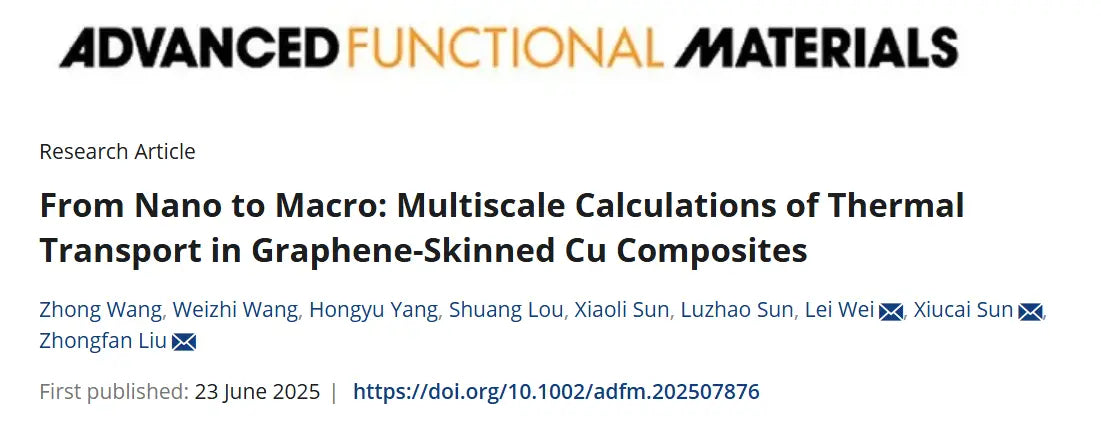With the rapid development of next-generation technologies such as 5G communications, artificial intelligence (AI), and high-performance computing (HPC), electronic devices are experiencing a substantial increase in power density. This trend has placed growing demands on the performance of thermal management materials. However, traditional metal-based materials are increasingly unable to meet requirements in terms of thermal conductivity and stability.
In response to these emerging challenges, copper/graphene composites have attracted significant research attention due to their unique structural properties and exceptional thermal performance. Nonetheless, conventional composites often suffer from limitations such as non-uniform graphene dispersion and agglomeration, which result in a pronounced gap between theoretical predictions and actual performance.
To address this, the research team led by Academician Professor Zhongfan Liu has recently published a study in Advanced Functional Materials, introducing a new copper/graphene composite material termed "Mengene Copper."
Key Findings
The study provides an in-depth analysis and quantification of the heat transfer mechanisms at the graphene–copper interface. Results show that phonon conduction accounts for 86.59% of interfacial heat transfer, while electron conduction contributes 13.41%. Through precise control of copper crystal orientation and optimization of graphene defect density and types, the team demonstrated that Cu(111) surfaces—due to their superior lattice matching with graphene—enhance phonon coupling and facilitate coherent vibrational energy transfer.
In particular, the presence of controlled graphene growth defects in the range of 10¹² to 10¹³ cm⁻² was found to improve interfacial phonon coupling, thereby increasing overall thermal transport efficiency.
Macroscale Thermal Conductivity
Building on nanoscale thermal interface simulations, the researchers extrapolated the macroscopic thermal conductivity of Mengene Copper. Notably, graphene grown on copper powder exhibited significantly higher surface coverage than on copper foil. Leveraging graphene’s outstanding in-plane thermal conductivity and interlayer heat transfer properties, the resulting composite forms a robust three-dimensional thermal network, markedly improving heat transfer pathways and system-wide cooling efficiency.
Under identical layer conditions, the thermal conductivity enhancement of Mengene Copper (powder-based) was up to eight times greater than that of traditional graphene-doped copper composites—clearly demonstrating its promise in high-performance thermal applications.

Figure 1. Design and Fabrication Process of High-Thermal-Conductivity Mengene Copper Composites

Figure 2. Longitudinal Heat Transport Mechanism and Influencing Factors of Thermal Conductivity in Mengene Copper

Figure 3. Effect of Graphene Layer Number on Thermal Transport in Gr/Cu and Gr/Gr Interfaces

Figure 4. Predicted Macroscopic Thermal Conductivity of Mengene Copper Foil and Copper Powder Composites
This work not only validates the conceptual design of graphene-skinned copper composites but also offers a theoretical framework for further material process optimization, property enhancement, and application expansion. The results lay a solid foundation for both industrial deployment and cross-scale scientific investigation of graphene and related functional composites.





Leave a comment
All comments are moderated before being published.
This site is protected by hCaptcha and the hCaptcha Privacy Policy and Terms of Service apply.